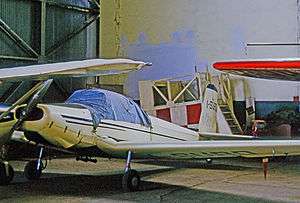Aviamilano Scricciolo
| P.19 Scricciolo | |
|---|---|
 | |
| Aviamilano P.19 Scricciolo at Milan's Bresso general aviation airfield in 1965 | |
| Role | Trainer |
| Manufacturer | Aviamilano |
| Designer | Ermenegildo Preti |
| First flight | 13 December 1959 |
| Primary user | Aero Club d'Italia |
| Number built | 50 + 1 prototype |
The Aviamilano P.19 Scricciolo (Italian: "Wren") was a light civil trainer aircraft built in Italy in the 1960s.
Design and development
The Scicciolo was designed at the Centro Volo a Vela del Politecnico di Milano to compete in a competition arranged by the Aero Club d'Italia for a light civil trainer. The aircraft was evaluated by the Milan Aero Club. The CVV P.19 emerged victorious and two batches of twenty-five were produced at the Aviomilano factory.
The Scricciolo was a low-wing monoplane with tailwheel undercarriage (although some were fitted with tricycle gear and designated P.19Tr). The pilot and instructor sat side by side under a large bubble canopy. The fuselage was of fabric-covered steel tube construction while the wings and tail surfaces were made of wood with plywood covering.[1]
After 1964, a few examples were fitted with 112 kW (150 hp) Lycoming O-320 engines for use as glider tugs and designated P.19R
Variants
- CVV P.19 Scricciolo
- The prototype designed and built at the Centro Volo a Vela del Politecnico di Milano for the Aero Club d'Italia competition for a new light civil trainer.
- P.19 Scricciolo
- The main production version of the Scricciolo
- P.19Tr Scricciolo
- Productionaircraft fittes with tricycle undercarriage.
- P.19R
- (R - Rimorchio - tug) Rebuild with 150 hp (112 kW) Lycoming O-320 for use as a glider tug.
Specifications (P.19)
Data from Jane's All The World's Aircraft 1965–66[2]
General characteristics
- Crew: two, pilot and instructor
- Length: 7.03 m (23 ft 1 in)
- Wingspan: 10.24 m (33 ft 7 in)
- Height: 2.02 m (6 ft 7 in)
- Wing area: 14.0 m2 (151 ft2)
- Empty weight: 525 kg (1,157 lb)
- Gross weight: 785 kg (1,731 lb)
- Powerplant: 1 × Continental O-200-A air-cooled flat-four, 75 kW (100 hp)
Performance
- Maximum speed: 210 km/h (130 mph)
- Cruising speed: 170[3] km/h (105 mph)
- Endurance: 5 hours
- Service ceiling: 3,100 m (10,170 ft)
- Rate of climb: 2.8 m/s (550 ft/min)
References
- Green & Pollinger, William & Gerald (1965). The Aircraft of the World. London: McDonald & Co (Publishers) Ltd. p. 84.
- Simpson, R. W. (1995). Airlife's General Aviation. Shrewsbury: Airlife Publishing. p. 407.
- Taylor, John W. R. (1965). Jane's All The World's Aircraft 1965–66. London: Sampson Low, Marston & Company.
- Taylor, Michael J. H. (1989). Jane's Encyclopedia of Aviation. London: Studio Editions. p. 88.
- World Aircraft Information Files. London: Bright Star Publishing. pp. File 889 Sheet 88.
See also
| Wikimedia Commons has media related to Aviamilano Scricciolo. |
Aircraft of comparable role, configuration and era